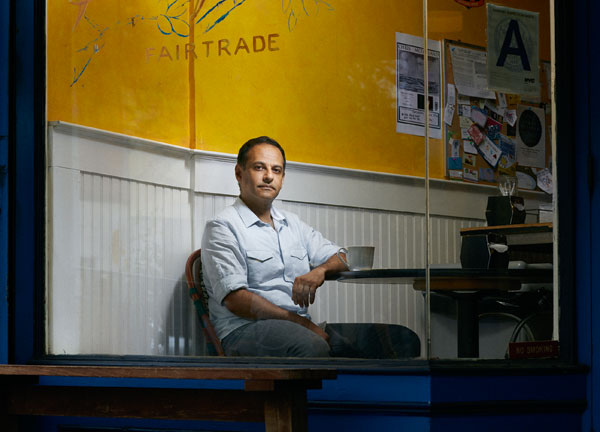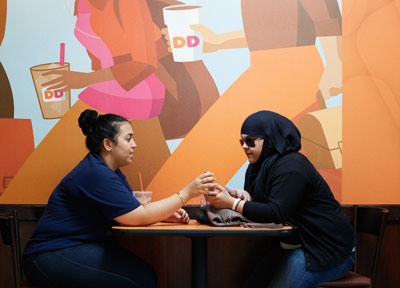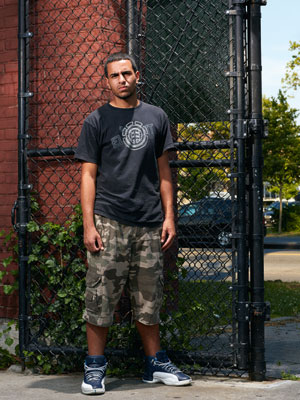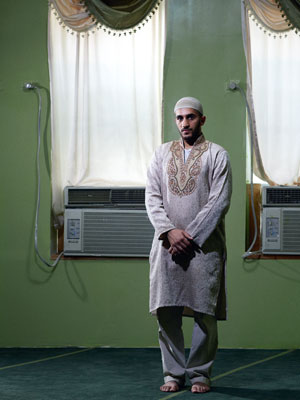Growing up Muslim in America

Simply sign up to the Life & Arts myFT Digest -- delivered directly to your inbox.
The sound of the muezzin calling Muslims to prayer rang out from the unassuming mosque on Fifth Avenue, the main drag in Bay Ridge, Brooklyn, one recent Friday lunchtime. “Hasten to the prayer, hasten to success,” the voice intoned in Arabic.
Bearded men hurried to the mosque, which opened straight on to the street, while one woman shrouded in black from head to toe yelled into her cell phone, also in Arabic. Another, in more colourful hijab, struggled in vain to divert her children’s attention as they passed a shop whose cheap toys had spilled on to the road.
With Ramadan approaching, the local Balady market displayed signs counting down the days until the holy month of fasting began, as shoppers navigated their trolleys around towers of imported dates and olive oil. Nearby, a shop touted “fashionable Islamic clothing” and a restaurant advertised “halal Chinese” – no pork, no alcohol. The scene could almost have been one from Cairo or Damascus, except for the shops with ads for phone cards in Spanish and the fact that the buses ran on time.
Bay Ridge is geographically close to the hipster Brooklyn neighbourhoods of Park Slope and Williamsburg but could not be more culturally different. It is a world away from the financial district in Manhattan, the epicentre of the September 11 2001 attacks. But Brooklyn is also home to the largest group of people in the US who trace their lineage back to the Arab world, according to census data. And while the heightened sense of a threat from Islamic terrorism that existed post-attacks may have gone, it has given way to a persistent, low-level paranoia that pervades the everyday lives of the million-plus Muslim Arab Americans living here and throughout the country.
Islamophobia in the US is becoming entrenched, according to some Muslim leaders. “We’re living in one of the most hostile civic environments for the Muslim community,” says Faiza Ali, a community organiser at the Arab American Association in Bay Ridge. “And it’s gotten worse since 9/11.”
Hate-crime statistics collected by the Federal Bureau of Investigation showed a sharp spike in violence against Muslims after the 2001 attacks, which levelled out until 2009, when it started ticking up again. There are always problems following events carried out by Muslims, such as the Boston Marathon bombings in March.
The US Equal Employment Opportunity Commission reports that in 2011, 21 per cent of the religion-based complaints it received were from Muslims – although they comprise less than 1 per cent of the population.
Situated in an old doctors’ clinic, the Arab American Association provides advice on everything from immigration to health insurance. It also fights practices it considers discriminatory, such as the New York Police Department’s surveillance programme, revealed in 2011, under which agents routinely observe Muslims going about their lives.
“Islamophobia has become institutionalised in New York – by our police department, elected officials, politicians who are running for office,” says Ali, a 28-year-old of Pakistani heritage, who became a student activist after being harassed in the wake of the 2001 attacks. “The environment is really difficult. It’s as if we are walking in a city that is our home but feeling like we are strangers,” she says in her office, where the walls are decorated with signs bearing slogans such as “Praying while Muslim is NOT a crime!”

Examples can be seen across the country. In New York, opposition has raged against Muslim community centres such as the Park 51 centre planned for near Ground Zero. In Florida, the pastor Terry Jones wants to burn Korans. In Tennessee, vandalism and bomb threats greeted plans to open a mosque in Murfreesboro. Then there are the attempts by state legislators in North Carolina and Oklahoma, among others, to ban recognition of sharia law.
“I feel like the anti-Muslim feeling has really become more pronounced in the last few years,” says Moustafa Bayoumi, a literature professor at Brooklyn College and author of the book How Does it Feel to be a Problem: Being Young and Arab in America. He cites polls from The Washington Post and The Economist that found that the number of people admitting to negative feelings towards Muslims had risen from the 20 per cent bracket in 2002 to more than 50 per cent by 2010.
When his book came out in 2009, Muslim readers told Bayoumi it painted too positive a picture, so much had the environment changed in the interim. It has since deteriorated further, he tells me as we sit in a café selling organic chai lattes in the trendy Brooklyn neighbourhood of Prospect Park. “It took a while for the narrative to take hold, that Muslims were the enemy population,” he says.
This is despite the fact that Islamic terrorism is well down the list of threats to life in the US. Thirty-three Americans were killed by Muslim-American terrorists between the 2001 attacks and the end of last year, according to Charles Kurzman, a professor of sociology at the University of North Carolina. Twice as many – 66 – were killed in mass shootings by non-Muslims in 2012 alone.
The US has been through periods of hostility towards ethnic groups many times before, for example towards German and Japanese Americans in the middle of the last century. But these have been discrete periods in history. There is no end in sight for the war on terror.
…
For me, this issue is personal. My son was born in America but has an Arabic surname and is growing up bilingual, although we are not religious in any direction. He has my lighter hair but his father’s colouring. Once, in an airport, a woman asked me what he was “mixed with”. A look that fell just short of horror passed over her face when I replied, “Iraqi.” I shudder to think of my son being on the receiving end of that look, just because of his name or the way his skin tans at the merest hint of summer.
I am one of many parents who worry. Arwa Aziz, a 41-year-old mother of two boys, moved her youngest son Adam, now 13, from public school to a private Muslim school in Brooklyn because she was concerned about him being bullied. “He got so shy as he was growing up, so I just thought he would be better off there,” Aziz told me while we talked at the Arab American Association, showing each other photos of our boys. “I tell my kids that they’re second-generation Americans, I won’t let them make us feel weak.”

Over iced coffee at the Dunkin’ Donuts on Fifth Avenue on a hot Saturday afternoon, Naemah Hegazy and her cousin, Bouchra Tabit, lobbed back and forth the observations of young women. Tabit joked about how she could be Miss Morocco, if only she lost 50 pounds, while Hegazy showed her funny posts on Facebook. When a Justin Timberlake song came on, they broke out together in an unrestrained: “Cause I don’t wanna lose you now, I’m lookin’ right at the other half of me.”
Hegazy, an 18-year-old of Egyptian and Moroccan descent, is studying political science at a college just north of New York City, while Tabit, two years her senior, has a part-time job at the local police station but is studying to become a nurse.
Both can rattle off tales of petty harassment – such as being called a terrorist and enduring “random” searches – that have been a constant presence in their lives since 2001, when they were just children. “We are singled out as a race,” Hegazy says, and Tabit chimes in about the times she has been told to “go back to your own country”. Hegazy bursts out: “This is not nobody’s country, yo.”
Many of the young Muslim Americans in Brooklyn can recount stories of public accusations of being a terrorist, rocks being thrown through their car windows, being targeted for “flying while Muslim”. Many know someone who has answered a knock at the door and found the FBI.
More than one-third – 36 per cent – of the American Muslim population is aged between 18 and 29, compared with just 22 per cent of the general public, according to the Pew Research Center. That means that an entire generation of Muslim Arab Americans has never known an adult experience where 9/11 was not somewhere in the backdrop.
Some young Muslim Americans have tried to hide their faith, removing any outward signs of Islam and changing their names. Mohammeds and Osamas become Mo and Sam. Some hope people will mistake them for Puerto Rican.
But academic research – including by Nadine Naber of the University of Michigan and Lori Peek of Colorado State University – suggests that a much larger number of young Muslim Americans have embraced their faith and are standing their ground in the face of widespread hostility.
A Pew Center study published in 2007 found that Muslim Americans under 30 were much more religiously observant than older Muslim Americans, a trend that experts say has only become more entrenched.
Hegazy and Tabit are both defiantly proud of their religion. Tabit, who has heavy black eye make-up underneath aviator glasses, advertises her faith with a tight black hijab, which she began wearing a year ago. “My friend’s mother died so I covered my head for the funeral, and I just never took it off,” she says. “Before I had guys trying to talk to me but now I don’t get much of that, so to me it’s about safety and respect.”
Hegazy, who goes to mosque as much as she can and observes Ramadan, plans to wear a headscarf one day. “I get a lot of questions like, ‘Why don’t you wear the hijab?’” she says, describing the novelty of being one of only five Arabs out of 1,300 students at her university. “I feel like it’s a personal choice and it’s between me and God. When I’m ready I will put it on but I’m not ready yet. It’s a lot of responsibility.”
…

Hegazy was voted “most likely to have her own TV show” in her high-school graduating class and dreams of being a political analyst on CNN or CBS. Holding an imaginary microphone up to her mouth, she does a little anchor-meets-rapper ditty. “Listen y’all don’t know, but Bill O’Reilly has to go,” she sings, referring to the conservative Fox News host who goes on regular rants about “Muslim jihadists”.
Tabit is assertive in other ways. She ticked the “African American” box on her college application form because her family comes from Morocco. “They told me I wasn’t black,” she says, giving a shrug.
Tabit’s mother Amina, who does not cover her hair, worries that her daughter will only suffer more discrimination as a result of her appearance, especially when she tries to get a job. “When she put on hijab, I was scared. I worry it will create problems for her,” she says.
Amina’s fears are rooted in reality. Saher Selod, a sociologist at Simmons College in Massachusetts, has done research on the “de-Americanisation” of Muslims. “Women in hijab are more likely to be targets for anti-Muslim ire, while it’s not usually until they give their name that the questions start for men,” Selod says. “People start wondering about their religion and what associations they might have.”
The prospect of being judged on their names plays on the minds of Nasr al-Zindani and Oaday Musallam, hanging out at the Stadium hookah lounge further up Fifth Avenue on a Saturday evening. Both sport painstakingly styled beards and smoke a hookah or shisha water pipe while watching Prison Break.
“My name is Oaday!” exclaims Musallam, a 22-year-old of Palestinian extraction who is now at business college and dreams of owning his own company “so no one can boss me around”. He shares his name with one of the sons of Saddam Hussein, the former Iraqi dictator. “I used to get a lot of trouble for that in school. Lots of ‘Are you Saddam’s son?’” he says.
In this environment of persistent unemployment, where there are many times more overqualified candidates than job openings, they worry that their names will count against them, that they won’t even get to an interview.
“Yeah, I worry about that sometimes, that they’ll see my last name and wonder about what connections we have,” says Zindani, who is 21 and whose parents come from Yemen. “It’s all about security. That’s what we love in America, that’s how it is.”
Zindani, who has just finished a degree in criminal justice, hopes to get a job in law enforcement. “I want to be a cop,” he says between puffs on mango-and-strawberry-flavoured tobacco. “I just want to get out on the streets and clean the bad guys out.”

Both men go on to recount a litany of occasions when they have been called terrorists or “Ay-rabs”, or been “jumped” while on the street, or verbally abused while working the counter in a deli.
Like Hegazy and Tabit, they don’t hesitate to defend themselves. “We feel like it’s right, when they talk about our religion and our beliefs, to defend ourselves, especially to people who we don’t know,” says Musallam.
They take an equally pragmatic approach to the suspicion that they automatically fall under. “There could be a lot of cops watching. They could be watching us right now. But I don’t pay any attention to that. If they do, they do. It’s not like I’m doing anything bad,” he says.
Like Musallam, Sadam Ali, who became the first Arab American to represent the US in the Olympics when he boxed in Beijing in 2008, also knows about having a difficult name.
“I like it because it’s a name that people don’t forget. I say, ‘Like Saddam Hussein and Muhammad Ali’,” he says as he play-spars with his five-year-old brother Adam at the boxing gym he started on Fifth Avenue. “I wouldn’t change my name for the world. You shouldn’t be judged on your name,” says Ali. “No matter what race you are, you can be successful when you work hard for something.”
…
Although many of the young people of Bay Ridge profess pride in their religion, the climate of suspicion about Islam is taking its toll on young Muslim Americans. Research by psychologist Mona Amer of the American University in Cairo and Joe Hovey of the University of Toledo has found elevated levels of depression among Arab Americans, most of them Muslim.
A quarter reported moderate to severe anxiety as a result of racial profiling and discrimination, according to a study published in the journal Social Psychiatry and Psychiatric Epidemiology. The results were especially striking given that admitting to mental health problems is generally considered taboo in Muslim culture.

Sami Nijam, a 15-year-old of Palestinian heritage, regularly gets called “Bin Laden junior” or a “terrorist” at his Brooklyn high school. “It’s supposed to be a joke but it gets to me a lot,” he says between shooting hoops with his friends. “People want to think we’re all the same [as the 9/11 bombers],” he shrugs.
For many in the post-September 11 generation, this suspicion about Islam has coincided with the period in their lives when teenagers are typically questioning their identity anyway. “There are a lot of negative feelings in the air. How do you reconcile all of these things about who you are suspected of being with who you know you are not?” asks Bayoumi. “That’s a difficult environment for anyone, let alone a 14-year-old, and it certainly contributes to their sense of frustration, or alienation.”
Many young Muslims have responded by seeking solace from their peers. There has been a sharp increase in Muslim students’ associations at universities, such as the Brooklyn College Islamic Society, which was targeted by the NYPD. Membership has doubled to almost 1,200 in the past three years. “They use the associations to find out who they are, a lot of that borne out of anxiety about being seen as unhuman,” says Bayoumi, who has become something of a one-man complaints department for Muslim students at the college.
…
The huge, four-storey Muslim American Society in Bensonhurst, an old wedding hall located between a police station and a playground, has also seen an increase in membership in recent years. The centre was a hive of activity one recent weekend. There was a big pre-Ramadan celebration on Saturday night, with a packed schedule of speakers and a dinner, and on Sunday the hall on the fourth floor was being festooned for a bridal shower.

Next door, a bunch of women were jumping and kicking their way through a boot camp class, enjoying the opportunity to shut the door and take off their headscarves. In the basement, a group of teenage boys were busily repainting the classrooms where Arabic and Koran lessons take place under the tutelage of Mohammed Almathil, the centre’s executive director. The noticeboard in the lobby advertised karate classes, football leagues and Girl Scouts.
The number of people attending Friday prayers at the centre has risen from about 200 at the beginning of 2011 to as many as 330 by the end of last year, according to Almathil, a Yemeni American who wears a short beard and a kufi, a small skullcap. Almost all of the increase has been driven by university students and young professionals. “The number one reason is that people are coming together for the comfort and spirituality, to help them deal with their daily stresses,” he says.
Almathil, who has a degree in psychology, says that institutionalised Islamophobia is causing some young Muslims to lash out on social media, while others respond by cutting themselves off from society. “They feel like they are being put under a lot of pressure so they are isolating or restricting themselves somehow,” he says.
Aber Kawas is a member of the Muslim Students’ Association at City College in Manhattan but calls the Muslim American Society her second home. “Young people feel like they are being attacked, like people don’t understand their way of life. Muslim kids become more into their identity in college and they flock together,” she says. “That happened to me. I would go to the MSA because it was comfortable.”
Kawas, known as Abby, is the American-born daughter of Palestinian immigrant parents, whose life was turned upside down after the September attacks. Her father got caught up in the law enforcement authorities’ terrorism fishing expeditions, leading to him being deported – even though he was never found to have been involved in anything related to terrorism.
Yet Kawas seldom stops smiling out from her tightly wrapped red headscarf. At her house, she tells me how she loves Jane Austen. She has read Pride and Prejudice more times than she can remember, not to mention watching the screen adaptations. “It’s just like our lives – we have social interaction but there’s no dating,” she says. “I feel like a Muslim Elizabeth Bennet.”

Then, down at the Muslim American Society, she invokes another British period drama to explain why she feels so comfortable there. “It’s just like that scene from Downton Abbey,” she says. “You know, when the rich people were sitting around with each other and they said, ‘Isn’t it so much easier when you don’t have to explain yourself?’”
Community organisers such as Faiza Ali have noticed that the climate of intolerance has essentially led young Muslim Americans to put themselves in self-imposed quarantine. They fear the impact that this will have on the development of civil society. “It’s scary when you think about the impact that this is going to have on future generations of activists,” Ali says. “If people are afraid to speak out now when they are in high school or college, what does this mean for the social justice movement?”
Others fear that society’s alienation of young Muslim Americans will contribute to some going off the rails. No one is drawing a direct line between membership of community organisations and young people being radicalised. But some wonder whether the alienation of a whole segment of society will tip those prone to radicalisation over the edge.
Jim Zogby, president of the Arab American Institute, a Washington think-tank, says the climate of suspicion creates a risk of instilling an “us and them” mindset in young Muslims. “What does all this do to their development and psyche, if they’re thinking, ‘They don’t want me here?’” he adds. A Maronite Christian whose family comes from Lebanon, Zogby has been the subject of headlines intended to associate him with extremists.
For her part, Kawas is conscious of the need to become part of her wider world, not just her Downton Abbey equivalent set. As we climb the stairs at the Muslim American Association, she looks at me and says: “If we all stay together all the time, people will never get to know us.”
Anna Fifield is an FT correspondent in Washington and begins a Nieman fellowship at Harvard next month. Her last story for the magazine was about Hispanic voters.
To comment on this article, please email magazineletters@ft.com
——————————————-
Letter in response to this article:
A bridge of reconciliation for Brooklyn / From Mr Charles G Westwater
Comments